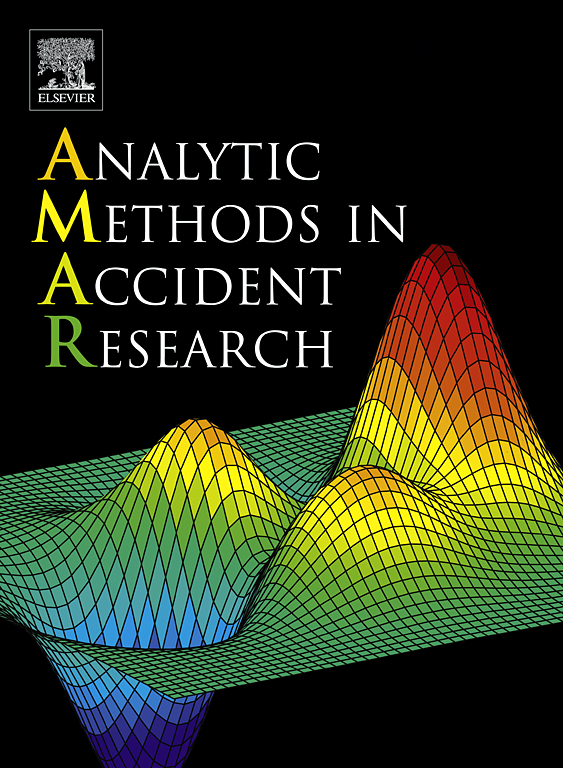Is there an emotional dimension to road safety? A spatial analysis for traffic crashes considering streetscape perception and built environment
IF 12.6
1区 工程技术
Q1 PUBLIC, ENVIRONMENTAL & OCCUPATIONAL HEALTH
引用次数: 0
Abstract
Modern streetview image data provide two types of valuable information: the objective built environment and humans’ subjective perception of the streetscape. In the road safety domain, the built environment has been identified as playing a significant role while indicators of human perception are commonly used to evaluate street quality in urban planning. However, studies examining the association between humans’ perceptions of the streetscape and traffic crashes remain limited. This study aims to address this question and to inform safety considerations at the micro level in the planning process for the targeted streets. To answer the question, this study integrates databases on motor vehicle crashes, points of interest, street view images, and road networks for the urban area of Daejeon city in South Korea in 2019. A deep learning model was employed to calculate six perceptual indicators–wealthy, lively, boring, depressing, safety, and beautiful–based on a crowdsourcing dataset. Furthermore, a Bayesian multivariate Poisson-lognormal model with spatial-varying coefficients was introduced to simultaneously account for spatial random effect and the shared unobserved effect across crash severity levels. Results indicate that four of the six perceptual variables significantly affect the number of slight injury crashes, showing spatially heterogeneous effects. Based on the values of human perception indicators and their impacts on traffic crashes, we identified road segments which need special attention to objective safety performance when considering street renovation. Additionally, built environment factors such as the proportion of vegetation, the presence of sidewalks and fences, and points of interest (including educational, health service, and commercial establishments) were found to reduce the number of motor vehicle crashes. Overall, the findings are expected to facilitate the safety-enhanced street planning project, and contribute to the development of human-centric cities.
道路安全是否涉及情感层面?考虑街景感知和建筑环境的交通事故空间分析
现代街景图像数据提供了两种有价值的信息:客观的建筑环境和人类对街景的主观感知。在道路安全领域,建筑环境已被确定为发挥重要作用,而人类感知指标通常用于评估城市规划中的街道质量。然而,关于人类对街道景观的感知与交通事故之间关系的研究仍然有限。本研究旨在解决这一问题,并为目标街道规划过程中微观层面的安全考虑提供信息。为了回答这个问题,这项研究整合了2019年韩国大田城市地区的机动车碰撞、兴趣点、街景图像和道路网络数据库。基于众包数据集,采用深度学习模型计算六个感知指标——富有、活泼、无聊、压抑、安全和美丽。此外,引入了一个具有空间变化系数的贝叶斯多元泊松-对数正态模型,以同时考虑空间随机效应和跨碰撞严重程度的共享未观察效应。结果表明,6个感知变量中有4个对轻伤碰撞数量有显著影响,且具有空间异质性。基于人的感知指标值及其对交通事故的影响,我们确定了在考虑街道改造时需要特别关注客观安全性能的路段。此外,研究发现,植被比例、人行道和围栏的存在以及兴趣点(包括教育、卫生服务和商业场所)等建筑环境因素可以减少机动车碰撞的数量。总体而言,研究结果有望促进加强安全的街道规划项目,并为以人为中心的城市的发展做出贡献。
本文章由计算机程序翻译,如有差异,请以英文原文为准。
求助全文
约1分钟内获得全文
求助全文
来源期刊

Analytic Methods in Accident Research
Multiple-
CiteScore
22.10
自引率
34.10%
发文量
35
审稿时长
24 days
期刊介绍:
Analytic Methods in Accident Research is a journal that publishes articles related to the development and application of advanced statistical and econometric methods in studying vehicle crashes and other accidents. The journal aims to demonstrate how these innovative approaches can provide new insights into the factors influencing the occurrence and severity of accidents, thereby offering guidance for implementing appropriate preventive measures. While the journal primarily focuses on the analytic approach, it also accepts articles covering various aspects of transportation safety (such as road, pedestrian, air, rail, and water safety), construction safety, and other areas where human behavior, machine failures, or system failures lead to property damage or bodily harm.
 求助内容:
求助内容: 应助结果提醒方式:
应助结果提醒方式:


